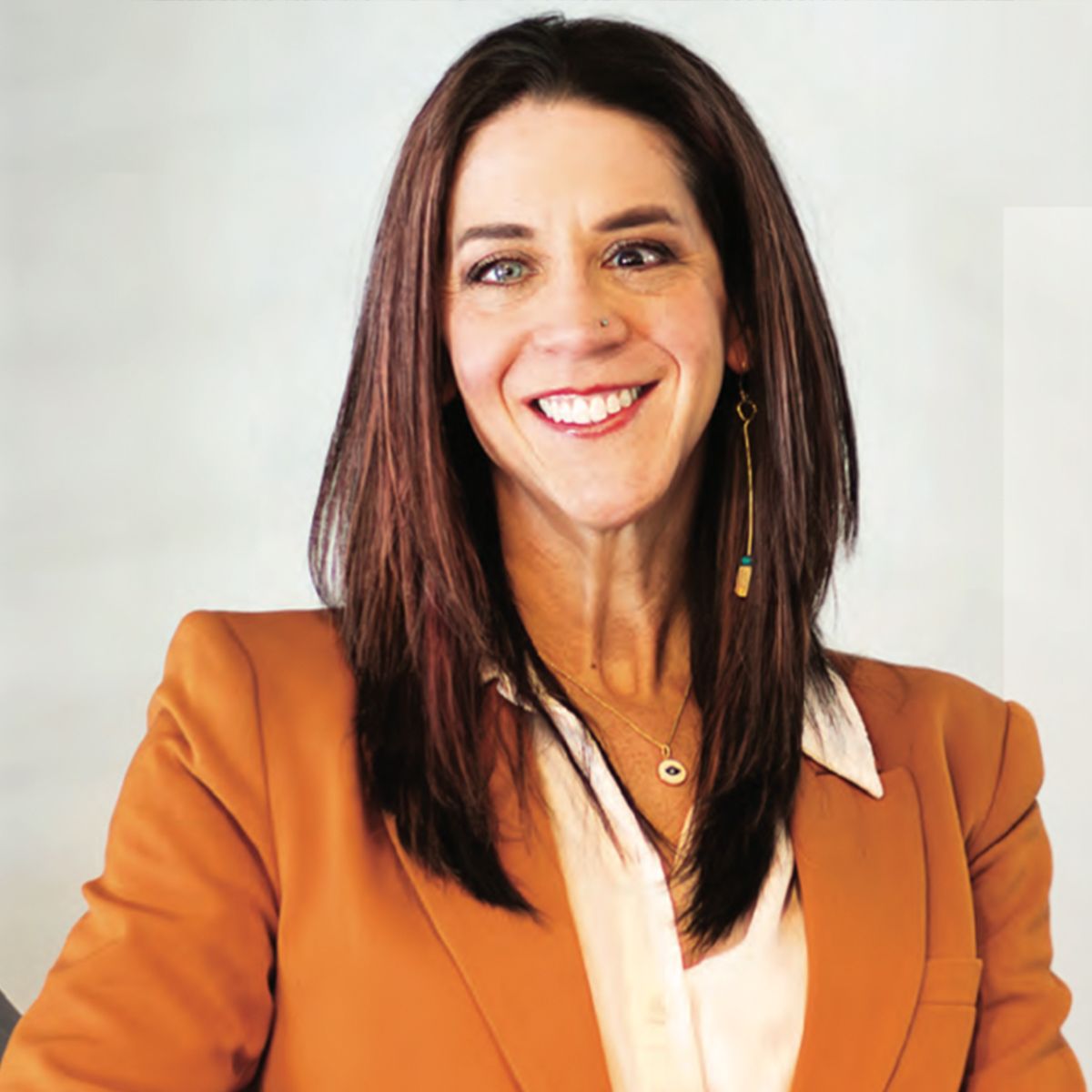Feature
Article
CURE
Speeding Up With CAR-T Cell Therapy in Multiple Myeloma
Author(s):
CAR-T cell therapy is moving to earlier lines of multiple myeloma treatment.
ELOUISE WRISPER, center, with her husband, JIMMIE WRISPER, and one of her daughters, SHANTRON ANDERSON. Elouise underwent CAR-T cell therapy for multiple myeloma earlier this year.
Photography by Gabby Barbosa

Elouise Wrisper’s cancer journey began with persistent back pain. It was 2021, and the retired teacher, who was active in her community and loved to take walks in the park, was experiencing discomfort that her primary care physician chalked up to sciatica.
“[My doctor] gave me steroid shots in my back. And in the process, I had a fall. And when I had the fall, I had an MRI, and that’s when they diagnosed me with multiple myeloma,” Wrisper, now 67, of Palm Beach County, Florida, says.
Wrisper would eventually be treated with the groundbreaking chimeric antigen receptor (CAR)-T cell therapy, first approved for the treatment of multiple myeloma in 2021.
The treatment became available sooner in the sequence of regimens for patients earlier this year, and researchers are awaiting more potentially practice-changing clinical trial results.
Harnessing the Immune System
“Multiple myeloma is a slow-growing cancer of plasma cells, of immune cells,” Dr. Rahul Banerjee, assistant professor in the division of hematology and oncology at the University of Washington and assistant professor in the clinical research division of the Fred Hutch Cancer Center, both in Seattle, explains. “It’s a common blood cancer, especially of older adults. ... For some patients, it’s not symptomatic at all and it’s just diagnosed with some anemia or some mild bloodwork abnormalities. For other patients, it’s very symptomatic, where they have kidney damage or bone lesions or fractures.”
“The idea is that you have these myeloma cells, which are the cancerous plasma cells. Plasma cells are immune cells that live in the bone marrow. They can, when they become cancerous, grow and grow and can chew their way out of the bone marrow into the bones around them. All plasma cells produce antibodies to fight infections or have responses to vaccines. Cancerous plasma cells produce junk antibodies, and those junk antibodies sometimes can directly cause kidney damage,” Banerjee explains.
The American Cancer Society estimates there will be about 35,780 new cases of multiple myeloma diagnosed in the United States in 2024.
Wrisper was initially treated with radiation, chemotherapy and a stem cell transplant, a process where a patient receives healthy blood-forming cells to replace those that have been destroyed by radiation or chemotherapy.
“I did have the stem cell [transplant], and it lasted for a little while, not quite a year, and I was doing better,” she says. “And then I was going back to my normal activities and doing things that I wanted to do. And then in 2023, that’s when it came back [to] me with a force. It was so painful. I was having pains down in my groin area. And with that, I had to be hospitalized.”
She resumed chemotherapy, but the pain continued to worsen. She returned to the Moffitt Cancer Center in Tampa, Florida, where she’d had her stem cell transplant, in October 2023.
“That’s when they found out that I had a lesion on my spine the size of an orange and it was pressing against my nerves,” Wrisper says. She was hospitalized until early December. She then entered a rehabilitation program to relearn how to walk and received more chemotherapy.
It was then that Dr. Doris K. Hansen of Moffitt Cancer Center’s Department of Blood and Marrow Transplant and Cellular Immunotherapy suggested CAR-T cell therapy, a process that removes the patient’s T cells from circulation, genetically alters them in a laboratory to be able to recognize and attack cancer cells, grows the cells in a culture, and then infuses them into the patient four to six weeks later.
“In February, they harvested my cells, and in April, they put them back in,” Wrisper says. “So now I’m doing much better. I’m doing things for myself again.”
‘The Holy Grail of Cancer Medicine’
CAR-T cell therapy, Hansen explains, “is an interesting and very revolutionary therapy. And it’s very unique in the sense that it’s the one-and-done approach and you can get a prolonged disease-free period. And it’s your own immune system doing a lot of the work here.”
“CAR-T cell therapy is a living drug,” Dr. Saad Usmani, chief of myeloma service at Memorial Sloan Kettering Cancer Center in New York City, says. “Our immune system has the capability of recognizing not just infectious agents that affect us. But our body’s cells make mistakes every day, and cancerous cells can arise, and the immune system can help to destroy those cells so that we don’t develop cancers. The holy grail of cancer medicine is somehow equipping our immune system to help fight those cancers. And that’s what CAR-T does.”
Although some types of cancer cells are capable of physically hiding from the body’s immune system, that’s not the case with multiple myeloma, as Banerjee explains.
“The [myeloma] cells are just sitting in the bone marrow, and our immune system does not know how to recognize them,” Banerjee says. “In general, I would say that cancers of the immune system often know all the tricks of the immune system and are able to bypass them. With CAR-T, you level the playing field.”
Moving to Earlier Lines of Treatment
In 2021, Abecma (idecabtagene vicleucel) became the first CAR-T cell therapy approved by the Food and Drug Administration (FDA) for the treatment of multiple myeloma when it was approved for the treatment of adults who did not respond to at least four prior lines of therapy or whose disease returned after the same number of therapies. Abecma became available sooner to patients in their treatment course in 2024, when the FDA approved it for adults with relapsed or refractory multiple myeloma who had received at least two prior lines of therapy.
Likewise, the FDA initially approved Carvykti (ciltacabtagene autoleucel) in 2022 for adults with relapsed/refractory multiple myeloma who had received at least four prior lines of treatment.
Earlier this year, it was announced that the agency had approved Carvykti for patients who had received at least one prior line of therapy. Earlier treatment means that a patient’s overall condition and organ function may be better and they could benefit from an extended remission sooner.
The research that could support a move to the front line of therapy continues. Hansen highlighted five current clinical trials that analyze this issue during a talk at the CURE Educated Patient. Multiple Myeloma Summit in June.
One cohort of the KarMMa-2 trial, findings of which were presented at the European Hematology Association Annual Congress, showed that among patients with newly diagnosed multiple myeloma that progressed within 18 months of treatment initiation, one infusion of Abecma resulted in “frequent, deep, durable responses and a manageable safety profile,” according to researchers.
Similarly, findings of the CARTITUDE-2 trial, published in Blood, showed that patients who received Carvykti in earlier lines of treatment “experienced deep and durable responses.”
Additionally, at the Educated Patient summit, Hansen spotlighted the KarMMa-9 trial, evaluating Abecma among patients with newly diagnosed multiple myeloma who experienced a suboptimal response to stem cell transplant, as well as CARTITUDE-5 and CARTITUDE-6, which will evaluate Carvykti among patients with newly diagnosed transplant-ineligible and transplant-eligible multiple myeloma, respectively.
Hansen says the issue of whether CAR-T cell therapy will make it to the first line of treatment is “the question everybody asks,” but researchers don’t have the answer yet. It will be another several years, for example, until the full results of CARTITUDE-5 and -6 are available, she says.
Usmani says there are also studies evaluating the sequencing of CAR-T with other immune therapies and a next generation of CAR-T cell therapies on the horizon looking at more effective ways of targeting cancer cells, as well as the possibility of expediting the manufacturing process and the development of CAR-T cells from the immune cells of individuals other than the patient being treated.
“I would say [for] CAR-T cells in general, not just for myeloma but for all cancers, we’re in the same place as we were for stem cell transplantation back in the ’70s and early ’80s,” Usmani says. “We have a long way to go. And I think we’ll be able to develop very effective therapies using this technology in the future.”
Side Effects
Common side effects of CAR-T therapy, according to the experts who spoke with CURE, include cytopenia, or low blood cell counts; cytokine release syndrome (involving symptoms such as fever, nausea, rash, headache, low blood pressure, rapid heartbeat and difficulty breathing after the rapid release of proteins known as cytokines into the blood) and neurologic toxicity as well as delayed neurologic effects with Parkinson’s disease- and Bell’s palsy-like features. These features, Banerjee notes, can include nerve weakness or facial drooping in addition to difficulty walking and moving. These are due to “off target” toxicities resulting from immune attacks on healthy cells.
It was reported earlier this year that the FDA had requested that five of the six agency-approved CAR-T cell therapies, including Abecma and Carvykti, come with a warning following reports of T-cell malignancies, including CAR-positive lymphoma, among patients who had received the treatment.
“The FDA has come out with warnings around the possibility of second cancers that have been reported in a very small proportion of patients who receive CAR-T cell therapy,” Usmani says. “And among those cases overall, with more than 20,000 patients having received CAR-T cell therapies, the total percentage of patients who had the second primary malignancies was less than 0.05%. So it’s quite low. It happens rarely, but it can happen, and some T-cell lymphomas were reported.”
There is also a potential issue with access because, as Hansen notes, CAR-T cell therapy is mostly administered at select academic centers. The treatment also requires significant time from the patient and a caregiver.
“There’s a lot of testing that is involved at different time points,” Hansen says. “There’s testing to ensure a patient has acceptable organ function. There’s restaging, meaning we need to see where the disease is before we move to CAR-T, and patients have to stay here for a period of 30 days so that we can monitor temporary side effects and manage them appropriately. But they also need a caregiver. So you have to have somebody who is essentially here to help care for you for at least a period of 30 days.”
CAR-T cell therapy, Banerjee says, is “not a walk in the park,” and although he advocates for its use in the third line of treatment and beyond, he says using it in the second line is a trickier prospect.
“CAR-T therapy is not perfect yet,” Banerjee says. “CAR-T therapy used to be in its infancy. Now it’s in its teenage years.”
Noting the potential toxicities of the treatment as well as other issues that may not make it logistically feasible or safe — such as the time commitment required of both patients and caregivers, complications that patients with heart issues could face due to a cytokine release syndrome-related fever, and the manufacturing time of four to six weeks, making the treatment unfeasible for patients with fastmoving disease — Banerjee still says the approach’s benefits outweigh its risks.
‘I’d Do It Again’
Lynn Robinson, who was diagnosed with multiple myeloma in 2008, is a world traveler and visited Belgium this summer.
Photography by Edina Dibusz

Lynn Robinson, now 74, was originally diagnosed with multiple myeloma in 2008 and underwent a stem cell transplantation in 2011, followed more than a decade later by treatment with Abecma in 2022, marking what Robinson recalls as being either her fifth or sixth line of treatment.
“In the last year before I had the CAR-T, I was definitely getting sick. … The [maintenance therapy] treatments I was having weren’t working,” Robinson, of Las Vegas, says. “And they started doing different types of immunotherapies … and I just kept getting weaker and having a lot more pain.” At a certain point, Robinson says, she was taking painkillers that included fentanyl and morphine.
After discussing CAR-T with her physician at the Robert H. Lurie Comprehensive Cancer Center of Northwestern University in Chicago, where they were only able to treat one patient each month with the therapy due to its limited availability, Robinson waited eight months for her turn.
Once she received the treatment, she experienced severe neurotoxicity. She says she was in a nonresponsive state for a few days, and when she came out of that, she couldn’t walk. Then, days after leaving a rehabilitation facility, she fell and fractured her pelvis.
“Shortly afterward, I thought, ‘I don’t think I’d ever do this again.’ But the benefits have been so incredible that I would do it again,” Robinson says, noting it took her approximately three months until she felt like herself again. Robinson, who lost approximately 3 inches of height before and during treatment, says she still has some pain but that she’s “completely free” of bone pain and shortness of breath.
“Ever since then, I have felt like a normal person,” she says, “like I’m not sick at all.”
For more news on cancer updates, research and education, don’t forget to subscribe to CURE®’s newsletters here.





